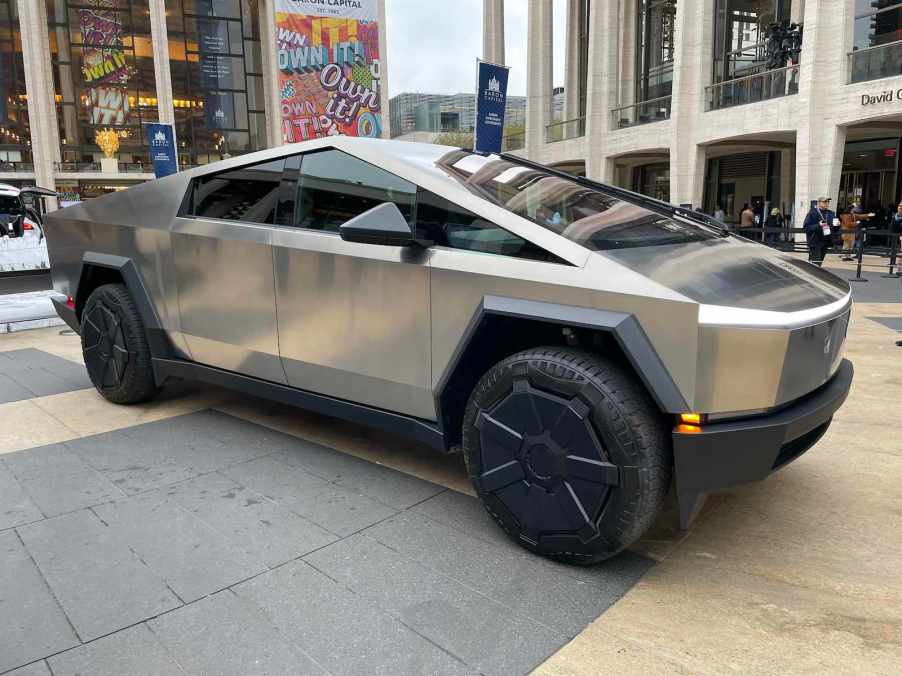
Op-Ed: Owners Complaining About Tesla Cybertruck’s 200-Mile Range Only Have Themselves to Blame
Tesla celebrated its first Cybertruck delivers on November 30th, 2023. Now we are finally getting range and efficiency reports from owners. The owners of what is almost certainly the first customer Cybertruck to hit 10,000 miles shared some disappointing statistics on an owners’ forum.
That 10,000 miles (which was split between two drivers and included one 1,500 mile roadtrip) is a good chunk of data. But first, those miles were 70% done on highways, 30% on city roads. And the owners report they drive mostly relatively aggressively.
At the 9,944-mile mark, this Cybertruck had averaged 599 watt-hours/mile. Its best was 290 Wh/mi and worst was 900 Wh/mi. The Cybertruck has a 123 kWh battery pack and advertises a 320 mile range. If you’re quick at arithmetic, you already know 599 watt-hours/mile won’t cut it. And you’re correct: these high-mileage Cybertruck owners claim their range was 164 to 206 miles.
A caveat here: that includes their range after 80% battery top-offs. These owners usually just charged to 80%, partly to preserve the battery lifespan, and partly because the Cybertruck proved so darn slow to charge (more on that later). With a 100% full battery, the range was usually closer to that 200 mile number.

Anyone who wants to roadtrip in an EV is finding that Wh/mi is a critical number. But charging speeds are nearly as important. A vehicle such as the Model 3, with its 50 kWh battery pack, offers seven minutes of driving time for every one minute of charging time. So a quick 30 minute charge translates to more than three hours of driving time. And future 800-volt compact EVs will do even better. Those numbers lend themself to roadtripping indefinitely, range anxiety be gone!
The Cybertruck is not a roadtrip machine. The high-mileage Cybertruck owners weren’t able to test a V4 supercharger. But they said charging to just 70% on a V3 took over an hour. And if they got stuck on a V2, they could be charging for two hours.
If you need to charge for over an hour every 200 miles, you ain’t going anywhere fast.
You’ll find some journalists dunking on Tesla after this high-mileage Cybertruck report. And I’ll say Tesla did advertise a 320-mile range. And to make matters worse, it is under investigation for dashboard range indicates that blatantly lie to drivers. And that’s downright unsafe.

But c’mon. This thing was never going to make it 320 miles on a charge. The Lightning has a bigger battery and a shorter range. The midsize Rivian R1T’s original configuration just beats the Cybertruck.
Folks, the Cybertruck is the size of a mountain and shaped like a brick. Anyone who’s tried to shape a paper airplane knows this this is the least efficient vehicle around. Loading it up with a bigger battery pack just makes it heavier and increases charging times. I don’t care what advertisers promised you, open your eyes. The Cybertruck was never going to be a good roadtrip rig.
In fact, until we invent a much better battery chemistry than lithium-ion, electric trucks and full-size SUVs will never be good at long-haul trips. And don’t get me started on long-haul towing.
Does that mean EVs are doomed? Heck no! In fact, Tesla is also pursuing the only sensible lithium-ion solution, small EVs with an excellent Wh/mi rating paired with a robust fast charger network.
Again, I’m the furthest thing from a Tesla apologist. But the truth is that trucks will need some energy source in addition to lithium-ion batteries to be a viable solution for most folks. In the meantime, if you want to take an EV on roadtrips choose a better tool for the job.



